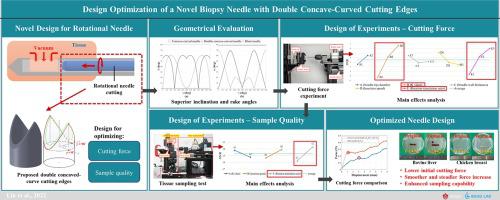IRBM ( IF 4.8 ) Pub Date : 2023-05-04 , DOI: 10.1016/j.irbm.2023.100783 Chi-Lun Lin , Yu-Ming Huang , Zheng-Yan Luo , Yu-Hsien Hsieh

|
Background
Vacuum-assisted biopsy is a minimally invasive sampling technique that relies on rotational cutting as a major tissue retrieving method. A precise diagnosis of the disease requires large, uncrushed samples, which are impacted by the cutting force of the biopsy needle.
Objectives
This study proposes a novel needle design with double-concave-curved cutting edges, which is more suited for rotational needle cutting. We aimed to optimize the design so that large, undamaged samples could be extracted with minimal cutting force.
Materials and Methods
Five-factor experiments were designed using the Taguchi method. Experiments involving rotational needle insertion and tissue sampling were conducted to examine the effects of these variables on the cutting force and sampling quality, respectively. The relationship between the cutting force and sampling quality was analyzed.
Results
For needle insertion, the optimal design within the design space demonstrated a marked improvement in cutting force from 1.2107 to 0.1888 N. Furthermore, the optimized double concave-curved needle outperformed the blunt needle under the same needle speeds, showing a 24.4% reduction in cutting force (0.1888 vs. 0.2496 N). Increasing rotation-translation ratio or insertion speed would allow for extracting a larger sample (increased up to 21.95% in weight and 17.21% in total length) but may also increase the rotation speed, resulting in sample fragmentation. To simultaneously improve sampling quality and cutting force, a higher K value, larger rotation-translation ratio, and slower insertion speed are suggested. Based on the conditions examined in this study, the optimal needle configuration should include a sharpened cutting edge with a K value of 0.2, a rotation-translation ratio of 8, and an insertion speed of 1 mm/s.
中文翻译:

新型双凹曲刃活检针
背景
真空辅助活检是一种微创取样技术,它依靠旋转切割作为主要的组织取出方法。疾病的精确诊断需要大量未破碎的样本,这些样本会受到活检针切割力的影响。
目标
本研究提出了一种具有双凹曲面切削刃的新型针设计,更适合旋转针切割。我们的目标是优化设计,以便能够以最小的切削力提取大的、未损坏的样品。
材料和方法
使用田口方法设计了五因素实验。进行了涉及旋转针插入和组织取样的实验,以分别检查这些变量对切割力和取样质量的影响。分析了切削力与取样质量之间的关系。
结果
对于针插入,设计空间内的优化设计表明切割力从 1.2107 显着提高到 0.1888 N。此外,优化的双凹弯针在相同的针速度下优于钝针,切割减少了 24.4%力(0.1888 与 0.2496 N)。增加旋转平移比或插入速度将允许提取更大的样本(增加高达 21.95% 的重量和 17.21% 的总长度),但也可能增加旋转速度,导致样本碎片化。为了同时提高取样质量和切削力,更高的K建议使用较大的旋转平移比和较慢的插入速度。根据本研究中检查的条件,最佳针配置应包括K值为 0.2的锋利切削刃、8 的旋转平移比和 1 mm/s 的插入速度。



























 京公网安备 11010802027423号
京公网安备 11010802027423号